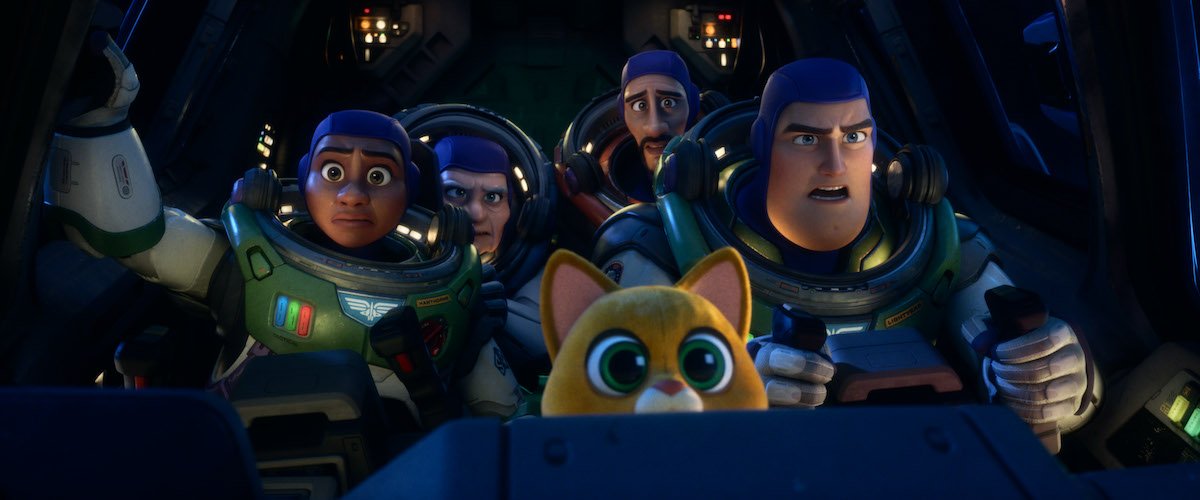LIGHTYEAR
Directing: C
Acting: B
Writing: C
Cinematography: B-
Editing: C+
Animation: B
At the beginning of Lightyear, we are informed that in 1995, Andy’s favorite toy, Buzz Lightyear, was a toy from his favorite movie. “This is that movie,” it says. After that movie finishes, though, I was left thinking about how children often have bad taste. Like, why would he obsess over toys from this movie?
It’s not that Lightyear is bad. It’s just . . . bleh. And when it comes to the bar set by Pixar Animation Studios in the nineties and 2000s, it might as well actually be bad. If it were actively bad, at least then it would be more interesting. Also, there’s a truly strange irony in this film: easily the most fun character in it is a robot cat, the kind of thing tailor made for merchandising. But in 1995, the marketers of this “movie” never made any toy SOX the Robot Cats to sell? And Andy was only interested in Buzz Lightyear, and (in the case of Toy Story 2), Zurg toys? Apparently Andy was a lot weirder kid than we realized.
Lightyear is clearly, objectively, a crowd-pleasing movie. The showtime I went to had plenty of actively engaged children in the audience, which erupted in applause when the film ended. It’s always so strange to me when people do that. Who do they think is there to appreciate it? This movie is getting relatively mixed reviews, and it’s easy to see why.
That’s why, even though the movie is successfully, if formulaically, entertaining, I found it to be kind of a bummer. I won’t go so far as to say Pixar has jumped the shark, but this movie is a definite step in that direction. We already got an arguably unnecessary Toy Story 4 in 2019, but at least it had the comfort of a familiar universe with long beloved voices. Now Disney and Pixar is just milking the original Pixar intellectual property for all it’s worth, branching out into odd-angled spinoffs.
And the thing is, the principal characters in Lightyear just aren’t nearly as compelling as those in the Toy Story series. That franchise had a novel concept: kids’ toys come to life when they aren’t looking. Lightyear is just a straightforward science fiction tale, with a lot of production design oddly reminiscent of the Alien franchise. Nothing here feels particularly original. I should be lauding Disney, I suppose, for making Lightyear’s best friend a lesbian (voiced by Uzo Aduba). But the trouble I have with this “feature” of the film is that it feels written expressly for that purpose, and that purpose only.
The one character I kind of loved was SOX, the aforementioned robot cat. Nearly all of the humor in Lightyear that actually lands is in relation to SOX. Very little of SOX’s critical role in the plot makes sense, but then neither does the rest of the plot. But, there are several gags delivered by or through SOX, as voiced by Peter Sohn, that got to me. I love me a cat character, even if it’s actually a robot, and any humorous bit involving a hairball. Or robot-paws typing away at a computer and figuring out complex equations. Everything about SOX is amusing and cute as hell. I wish the movie had been about SOX.
Chris Evans is well cast as the voice of Buzz Lightyear, but Lightyear lacks a certain angle, maybe even a gimmick—like, say, a Buzz Lightyear toy who doesn’t realize he’s a toy. That’s funny stuff. The “movie character” Lightyear just has to learn to accept that he makes mistakes. Yawn!
There’s a lot of time-travel that happens in Lightyear, with the title character obsessively “testing the hyperdrive” of a ship meant to get a marooned community off of a hostile planet. These are complex ideas that must by definition be oversimplified in an animated feature, and every time Buzz leaves the planet, only a few minutes go by for him but anywhere from four to 22 years passes for the people on the ground. This is how he winds up returning after one of many trips to find his best friend has passed away, and later meeting her grown granddaughter, Izzy (Keke Palmer). I’d be a lot more interested in a live-action drama about the implications of these evolving relationships.
But, of course, I’m a sometimes cynical 46-year-old, trying to hold Pixar to the same standards they had 27 years ago. That fact would be easier to dismiss if not for the fact that Lightyear exists on the assumption of an audience connection with a film that came out 27 years ago. True, the Toy Story movies have captured the imaginations of multiple generations of children, but it’s difficult to see how any of them will connect with Lightyear the same way just because of that tenuous connection. The young children dazzled by this movie don’t know any better.
The animation is competent, at least, if not jaw dropping the way that so many of Pixar’s previous films have been. And while Lightyear is engaging from start to finish, if a little rushed in its plot development (something no child is going to give a shit about), there’s a bit of Pixar soul that feels like it’s missing. I may need to rewatch Soul (2020) just as a palette cleanser.
We’re also treated to Taika Waititi and Dale Souls as … more forgettable characters. Stick with SOX the robot cat.
Overall: C+

